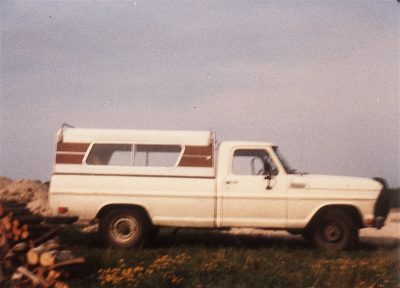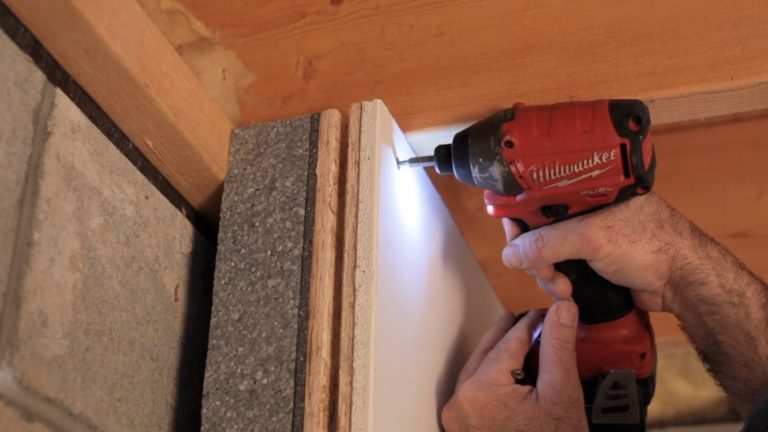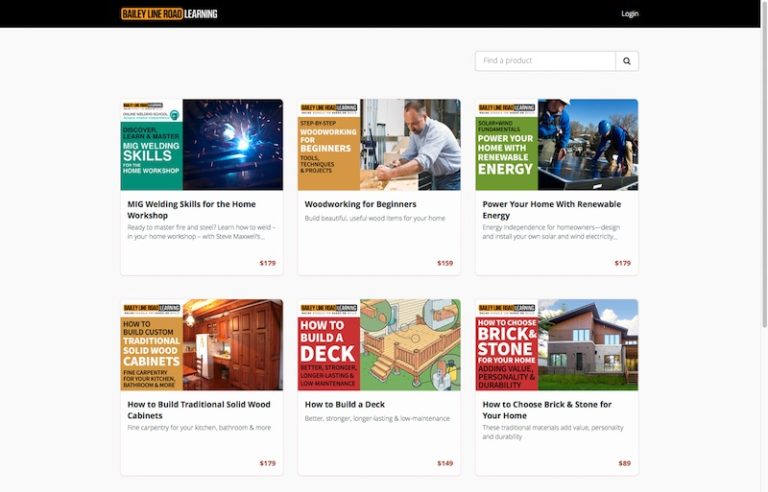This is the second chapter in my true story about moving from the city to a rural property on Manitoulin Island 30 years ago, and the adventures of living here since. Click here to go back and read Chapter One.
***********************
THE BAILEY LINE ROAD CHRONICLES: CHAPTER TWO – THE WAKE UP CALL
I woke up with the rising sun on the morning of Thursday May 15, 1986 in a tent pitched on my homestead property. It was my first morning on the land, I was there by myself, and it was one of the most sharply depressing moments of my life. It was all I could do to stop myself from running away from the crazy venture I’d gotten myself into. Buying my homestead property the previous fall had been a dream come true, but somehow it had morphed into a nightmare, though for no outward physical reason. My distress was entirely internal.
My overwhelming eagerness to get started building a house and gardens had felt like Christmas morning that past winter after I bought my property, and I was giddy with anticipation to get going with the homestead dream. But now that I was here, on my own chunk of Manitoulin Island, I was homesick enough that I felt like crying. That’s what happens to some 23-year-olds when they’re far from family and friends, living in a 7×9 foot tent eating cold ravioli out of cans while sitting in the cab of an 18 year old pickup truck that might break down at any moment. I was in the depths of despair and surprised I’d been too blind to recognize my own stupid choices. The task ahead of me was way too big, way too unlikely to succeed and altogether ridiculous. I was convinced that my insanity for homesteading had finally caught up with me, and I’d lured my girl friend Mary into the folly. While all our friends down south were showing off their new business cards and taking swanky overseas trips for their new careers, I’d just spent all my savings and then some on a chunk of property in the middle of nowhere, without any buildings, no water well, and nothing but tumbledown fences and forest surrounding me. The weather was bright, the air had that intoxicating smell I only ever find during the Manitoulin spring, bluebirds and loons and deer were all around me, yet it all seemed so insane. I was a young idiot and I’d thrown my life away. An entry from my diary that first morning paints the picture. The world was brighter than it appeared to me then, but sometimes illusion seems like reality:
“This first journal entry describing my house building adventure on Manitoulin Island is not at all what I or you would expect. To be specific, I feel that I’ve lost all heart for the long and ambitious (idealistic?) project. I believe that a good portion of this condition is due to loneliness, but there are several other factors at work also. The strangest of these is a kind of loneliness brought on by the lack of all the city noises and smells that I’ve come to think I dislike so much! Since I’ve been here I haven’t heard any mechanical noises of any sort, except for a grader which woke me up this morning. I was unpleasantly surprised to find that my heart leapt for joy when I heard that ugly monster going down the road! Obviously, I haven’t the slightest idea what I want or need in a lifestyle, and I feel that I’ve made a mistake coming to this island in the first place. To be fair to this lovely piece of property, I must say that it is peaceful and abundantly populated with wildlife. There are birds singing constantly, and their sound is very beautiful. The land has a wonderful smell; the combination of the budding leaves and wet soil (it just stopped raining here after I arrived yesterday afternoon) and the air off the open waters of Lake Huron. But somehow these things are not enough to change the way I feel. I’m very discouraged and unsure of what to do.”
 I see now that this first “black moment of the soul” on the land was a kind of test. Homesteading isn’t going to let you succeed if you’re swayed by feelings. There must sometimes be an iron resolve to continue despite feelings and the apparent insanity of what you’re facing. As I know now, this is the same challenge faced by anyone who builds something beyond what others have already made. This is true whether your dream is a business, an invention, a new homeland or anything else that involves creative choices, hard work and uncertainty.
I see now that this first “black moment of the soul” on the land was a kind of test. Homesteading isn’t going to let you succeed if you’re swayed by feelings. There must sometimes be an iron resolve to continue despite feelings and the apparent insanity of what you’re facing. As I know now, this is the same challenge faced by anyone who builds something beyond what others have already made. This is true whether your dream is a business, an invention, a new homeland or anything else that involves creative choices, hard work and uncertainty.
After living submerged under this black despair for a few days, trying to get my bearings, the logical side of my homestead dream started coming back. A glimmer of enthusiasm followed. Not strongly at first, but it was enough to keep me going.
“This is good, fertile land at a good price.” I pointed out to myself.
“After all, I have to live somewhere”, I reasoned. “Why not here?”
“Most people spend decades building a house via a mortgage. I’ll do it slowly, directly and economically, without losing anything to the bank”, I argued.
In the end, I made a deal with myself. I’d completely ignore my feelings and soldier-on for two full weeks. If after two weeks I still felt terrible, I could always call that German real estate agent Kitty Grigull we’d bought from and have her sell the property once more. As it turned out, two weeks turned out to be more than enough. In about a week, logic won out over emotions on the idea that my homesteading plan really was still a good idea, and that the volume of work ahead of me was no different than the volume of work facing anyone with a regular job and a regular life. The only difference was that I could see it all looming ahead of me like a mountain, while the enormity of a future of 40 years spent in a wage job paying down a mortgage was somehow easier for most people to ignore. In the end, I did get past this first psychological homesteading test, soon to be followed by another challenge that was entirely different. It had to do with my sense of priorities and how little I knew about managing my own time independent of a boss or formal work structure.
What I know now but didn’t realize then was how much pointless hard work an eager guy from the city can do before he learns to discern what work really matters and what work is pretty much a waste of time. Going off on useless but fun tangents is the biggest danger that any beginning homesteader faces, and my first couple of months on the land included these waste-of-time, non-priority follies:
- Trying to break heavy sod and start a garden with nothing more than a shovel and seed packages, even though I had nothing resembling a proper shelter to live in. Lesson learned: When you don’t have a house, gardening is a hobby, not the main event.
- Trying to resurrect a fleet of 60 year old discarded farm machinery in preparation for my life doing some unidentified but profitable agricultural pursuit. Somehow I didn’t notice that well-equipped, third-generation farmers all around me were barely making ends meet using great equipment, while I intended to succeed using equipment their grandfather had discarded as impractical back in the 1920s. Lesson learned: You need proper tools to achieve successful results.
- Beginning to dig a basement hole for a 34’ x 44’ basement in hard clay soil using nothing more than a shovel. It took me two weeks of digging to create a hole large enough to put a phone booth in. It took a man and a backhoe 4 hours to dig out the entire basement hole at a cost of $300. Lesson learned: Heavy equipment is sometimes a Godsend.
- Fixing pasture fences when the only animal I owned was an ill-tempered golden retriever named King. Once again, my agricultural tendencies were getting the better of me. I didn’t even know how to fix a cedar rail fence. Lesson learned: Don’t confuse agricultural pursuits with what it takes to succeed in the country.
- Planting peas in a patch of soil I scraped clear in the forest, hoping for a healthy abundant harvest with no work from me. The earth does not yield food willingly. All that happened is that a deer enjoyed half a mouthful of pea seedlings one night. That ancient passage about “by the sweat of your brow you will eat your food” is entirely true. Lesson learned: There’s a reason why people go to a lot of trouble to grow food. They have to. The natural world is not the Garden of Eden.
Most of the insights in my life happen in a moment, and a heavy thunderstorm one dark night triggered an insight that snapped me out of my treadmill of hard but misdirected work. I was still alone on my land, and I had to leave my tent to pay an urgent visit to the poplar log that passed for a latrine seat I’d set up over a crack in the limestone bedrock near my tent, and I knew what I really needed in a moment. There I was, sitting on a log with my pants down, in complete darkness while a torrential downpour soaked me to the skin while using “the facilities” such as they were. Mosquitos were part of the equation, too.
 “Tomorrow I’ll start to build an outhouse,” I vowed. It was the first sensible thing I’d done since arriving on the property some months earlier, but in true greenhorn fashion, I built it in an especially difficult way.
“Tomorrow I’ll start to build an outhouse,” I vowed. It was the first sensible thing I’d done since arriving on the property some months earlier, but in true greenhorn fashion, I built it in an especially difficult way.
People often attempt homesteading with the idea of treading lightly on the planet, and that’s a good thing. Good within limits, that is. I had to learn that human beings can never live completely in harmony with nature this side of eternity. In the case of my outhouse, I ventured beyond the limits of good sense with my conviction to build an outhouse from reclaimed lumber. Having been assured by all the homesteading books I’d read for years that wonderful, “pre-used” lumber was everywhere in the country (the value of which somehow escaped all the locals who kept paying good money for new lumber even though they apparently didn’t have to) I ventured to find some old boards. I consulted my new neighbour, that spry 76-year old township icon named Ivan Bailey who showed Mary and I the property when we were looking to buy.
“Where can I find some old lumber to build an outhouse with?”, I asked Ivan one afternoon in his kitchen. Ivan looked up for a minute, staring into the air above my head, searching his data base of knowledge that rural old-timers seem to have for the tiniest details of the personal lives of their neighbours.
“Ches Bailey over on the Blind Line has a pile of old lumber in the middle of one of his pastures,” Ivan told me. “It’s good cedar, but full of nails. Ches lives about 5 miles away, he’s my cousin (as most people in the township seemed to be). I’ll call him.” Ivan grabbed the receiver of his rotary dial, party line telephone and in an hour Mary and I were knocking on the door of the most authentically-rural people I’d met in my life to that point.
Manitoulin Island is as far into the country as agriculture gets and it still contains many old ways and the kinds of people who’ve gone extinct in most other parts of the world. The little corner of Manitoulin I’d bought into was like the Ozarks of Ontario.
Ches and his wife Floris lived in the tiniest house I’d ever seen. It looked like an over-grown playhouse. Doorways were small and ceilings low, but the shape was nice. Imagine an ordinary steep-roofed, classic home scaled down by about 40% and you’ll get a sense of the place. They’s never had any children and the couple was sitting around the dinner table, eating a meal of boiled potatoes and wieners when I arrived.
“Would you like some?” Floris asked. She’d never met me before, but that’s the kind of hospitality I’d see again and again on Manitoulin. “No thank you. I just ate. But you go ahead and finish.” Like I said, the hospitality of many country folks here still takes my breath away. I try to extend it myself in the same way whenever I can.
In almost perfect silence we sat there in the tiny kitchen, me watching this sweet couple in their 70s quietly eating wieners and potatoes and sipping mugs of hot water as they probably had every night since they got married back in July 1946. I’d never seen people sit down and enjoy hot water as a beverage before, but as I’d learn it was not unusual among the old timers in my corner of Manitoulin at that time. There was almost no conversation during dinner, and it seemed quite likely their meals were always like this. It was the kind of situation where you definitely wanted to chew with your mouth closed.
Over the years I’d eventually learn that Ches was probably the slowest driver in the world. For reasons I don’t understand, he’d drive the 12 mile run into the town of Gore Bay two or three times a day, just for something to do. Most of the route is a blacktop highway with a speed limit of 50 mph, but Ches would make the trip at a safe and sane top speed of 25 mph on the straight-aways. If you ever got behind Ches on the road (and this was quite likely given how often he went to town), you were going to be late for your doctor’s appointment.
Eventually dinner was over and Mary, Ivan Ches and I ambled out into the pasture to see the pile of half-rotten boards. Amazing as it was, Ivan’s rural database of local details had done the job, as it would prove to do for the remaining 10 years of his life. He had somehow known about and remembered a pile of old lumber sitting in the middle of a tired pasture, completely out of sight and 300 yards from any road. His description of cedar with lots of old nails was accurate, too. $15 lighter in my wallet and we were loading the boards into the truck to bring this horde of “old gold” back to my property. Ches and Ivan both helped. It was the kind of wood I’d never build with now because some of it was too old and sections were punky and needed to be cut out and thrown away. But for a frugal guy with a bank account hovering around $200 that day, and memories of sitting on a latrine log in the middle of a pitch-black nightmare thunder storm, the prospect of an outhouse made me feel like a king even if my palace was going to be made of old wood.

Buying a pickup truck was one of the good decisions I made earlier that year as I was living in my parents’ house, and it was paying off now as we trundled back to my property with those precious old boards stashed in the back. Earlier that year, in the spring of 1986, in preparation for my time on Manitoulin, I’d answered a newspaper ad offering a 1968 Mercury F250 pickup truck for sale in Toronto. The owner and I agreed to a price of $600.
The truck was hidden deep in a back laneway, in one of those old Toronto neighbourhoods where houses didn’t have driveways because nobody owned cars when the lots were surveyed and houses first built back in the early 1900s. The truck was beige, covered with a couple of coats of brush-applied Tremclad paint. Rust bubbled up from all the usual places. Evidence of old bondo was ample and large. A tall cap covered the box.
All in all, it was an ugly truck, but I chose it. I was told the thing would run, but the brakes were shot, so I traveled down from suburbia on public transit carrying as many mechanic’s tools as I could. The year before, my parents had given me a nice set of Craftsman socket wrenches and other tools, and this would be my first time using them seriously. Thirty years later I still have and use these tools a couple of times a week, so it was a great gift.
My plan had been to jump-start the engine, make sure it ran decently, then pop over to a nearby Canadian Tire store and buy a new master cylinder to get the brakes working again. I’d drive the truck to my parents’ house after getting the brakes working, using the owner’s old plates, then do a complete make-over of the old truck. I’d never worked on brakes before, but I’d studied a Reader’s Digest book on automotive systems and this somehow gave me the confidence to diagnose the master cylinder as the problem. As it turned out, I was entirely wrong and so was my plan to swap out the part while working in a back lane of an old neighbourhood using only the tools I could carry on the bus and subway. One thing I’ve learned is that reality is not polite. It doesn’t care how right you think you are. Reality always gets its way.
 In the end, after struggling pointlessly for 3 hours and getting nowhere, I called a tow truck on a pay phone and had the old jalopy towed to my parents driveway 20 miles away. The $60 towing fee was a financial blow of major proportions to me at the time, but what could I do except feel queazy and carry on? I kept the new master cylinder for that complete rebuild of the brake system I’d planned to do later that spring, before driving off into the country.
In the end, after struggling pointlessly for 3 hours and getting nowhere, I called a tow truck on a pay phone and had the old jalopy towed to my parents driveway 20 miles away. The $60 towing fee was a financial blow of major proportions to me at the time, but what could I do except feel queazy and carry on? I kept the new master cylinder for that complete rebuild of the brake system I’d planned to do later that spring, before driving off into the country.
One of the things I’ve noticed about young people today is that few of them seem willing to struggle. This isn’t universal, but nothing ever is. The typical response to a challenge for which no smartphone app exists is to raise the white flag of surrender. That’s too bad because wrestling with your challenges is a great way (perhaps the only way) to grow as a human being. What troubles me most is that so few young people seem interested in paying the price to grow.
With the Mercury F250 in my parents’ driveway and 6 weeks to get it ready for that first big trip to Manitoulin, I had some struggling and growing to do. My plan was to change everything that might break or pose a safety hazard on that truck. After all, it was 18 years old at the time, so anything could happen. In the end, I changed the entire braking system from master cylinder to wheel cylinders. The old girl had drum brakes all around, so I changed those and the brake shoes, too. I also changed the clutch (my diamond-in-the-rough had a 3-speed on-the-column shift), installed a new starter motor, a new battery (of course) and fixed holes in the floor through which you could see the road sliding past. The box had rust holes clean through too, so I bolted down a layer of 7/8″-thick maple boards to form a new floor. The truck was far from certifiable when I got it, in part because not all signals worked, the horn was silent and the tires were mounted on a kind of rim they stopped making a long time ago. Each rim was made of two parts that snapped together in the middle. Tire guys called them “window makers” because of their tendency to blow apart as air pressure was applied.
By the time I’d wrestled with all these things and made them right, I’d put $1000 of parts and 6 weeks of time in the truck to get it certifiable. I learned so much in those struggles that still helps me today, including the fact that sometimes you need the advice of an expert. The most challenging problem I faced was getting all the air bled out of the hydraulic lines in the new brake system. No matter how I followed that Reader’s Digest how-to book, the brakes remained soft, full of air bubbles and ineffective. I’d gone through three cans of Dot 3 brake fluid, with nothing to show for it.
With no YouTube or online forums to consult, I visited a mechanic who owned a local Shell garage near my parents’ house. I’d never met him before, he was about 15 years older than me, his name was Mike, and he introduced me to what’s called “the gravity bleed”.
“I’ve got a tool for bleeding brakes quickly, but you don’t need one. Just keep the brake fluid reservoir open and topped up with fluid”, Mike explained “then open all the bleed screws on the wheel cylinders at once. Put tubing over each bleed screw leading into a jar or can to catch the fluid. It’ll drain out slowly on its own over hours, bringing any air bubbles with it. Close up the bleed screws and your brakes should be good and firm.” Mike was a generous genius with his advice and he was right. The gravity bleed worked perfectly the first time while also proving that there are kind people in the city, too. When I was all done my rebuilding, I brought the truck to Mike for certification. It passed without issue and the experience left me with valuable skills learned in the “school of struggle”.
In the end, I drove that 1968 Mercury F-250 for 18 more years and 200,000 miles before replacing it with a Ford F-150, only because it had four wheel drive. The F-250 never let me down, though I did have a near fatal wheel rim failure on a major Toronto highway, thanks to a backwoods mechanic who couldn’t weld nearly as well as he thought he could. That day is one of many that makes me thankful for a little good luck. More about luck later.













